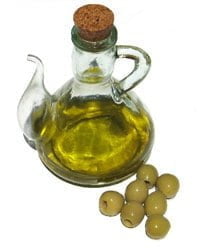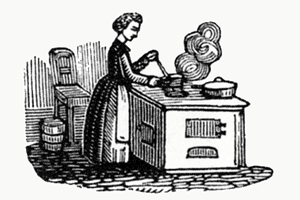Types of Olive Oil
It is good to understand the different types or grades of olive oil to help you select the appropriate uses for this healthful and flavoursome type of fat.
The basic types of olive oil are:
There are other forms described below, but these are blends and are not part of the formal grading process.
Extra Virgin Olive Oil

Extra virgin olive oils are sometimes treated like fine wines, and, as with wines, some people will argue that no two olive groves will produce extra virgin olive oils that taste alike. The seasoned palate is able to detect distinctions in taste and aroma, and these subtleties are extensively discussed and intensely debated.
To be certified for the “extra virgin” label, an olive oil should satisfy four criteria: it must be produced by mechanical extraction methods (no chemicals or hot water applied), come only from first cold-pressing, have an oleic acidity level of less than one percent, and must have a perfect taste.
Acidity level is the most important factor that determines its grade. This is a measure of the percentage of free fatty acid content: the best oil has the lowest acidity. The oil should also be free from perceptible defects in taste or smell. Extra virgin olive oil is valued for its perfect balance in terms of flavour, aroma, colour, and acidity level.
One reason extra virgin olive oil is prized so highly is its high content of vitamins and nutrients. Also, it is pure and without any additives. The fruitiness of its taste and the complexity of its aroma give it universal appeal. The light, delicate consistency of extra virgin olive oil makes it perfect for dressings. It is also the preferred oil for use in cooking by more discerning users.
Extra virgin olive oil comes in four sub-types:
- Extra virgin olive oil (regular)
- Organic extra virgin olive oil
- Protected Designation of Origin (PDO)
- Protected Geographical Indication (PGI)
Different extra virgin olive oils may share the same characteristics but there is marked variation in taste. There are many nuances, and connoisseurs categorise its flavours as mild (delicate, light, or buttery), semi-fruity (stronger, with more taste of olive), and fruity (oil with a strong olive flavour).
If you wish to become familiar with the different olive oil flavours, you should try to taste as many of them as possible; one cost-effective way to do that is to split several large bottles of different extra virgin olive oils with your friends.
Virgin Olive Oil
Virgin olive oil also comes from the first pressing, and is also produced without refining. In a technical sense, virgin olive oil may have an acidity level of up to 3.3%, however, industry practice in the producing countries is to maintain under 2% acidity. Its flavour intensity can vary and its taste is less mild than extra virgin olive oil.
Pure Olive Oil
This is now simply called olive oil and is a blend of virgin olive oil and refined olive oil. Its label will bear the designation “pure” or “100% pure”. However, refined olive oil has very little vitamin E content. This is why producers need to add unrefined virgin olive oil to impart some of flavour, colour and aroma into the blend. The proportions of the two components may vary from one producer to another, depending on the flavour the producer desires to create.
Pure olive oil actually has the same acidity level as virgin olive oil, and for that reason it has good resistance to high temperatures. Its lower nutrient content than virgin olive oil makes it less expensive. It cannot be used for dressings and is better suited for heavy-duty, high-heat cooking.
Olive Pomace Oil
Pomace oil is the lowest grade of olive-based oils. Pomace is that part of the olive that remains after all the oil and water in it has been removed by pressuring or centrifuging processes. With the use of certain solvents, there is still some residual oil that can be extracted from the olive pomace. This oil may then be refined, which results in a product bereft of any specific taste or colour; it also contains none of olive oil’s vitamins.
To make pomace oil acceptable to consumers, the producer blends it with virgin olive oil. As with pure olive oil, the producer may vary the proportions between the pomace oil and virgin olive oil; however, the virgin olive oil content is generally quite low. The blended product is called olive pomace oil. Like pure olive oil, it is suitable for use only in high-heat cooking.
Lite Oil
There are certain light-tasting, light-coloured oils containing minute proportions, if at all, of virgin oils. These are pure rectified oils called lite oils. They are being marketed with a particular slant that would have people believe that they are buying oils that have lower in fat or calorie content. The truth is, lite oils have 125 calories per tablespoon – exactly like all olive oils, and all fats, for that matter.
Grading of olive oil is done, to a less significant degree, based on colour. Most olive-based oils have colours ranging from pale yellows to deep cloudy greens. The latter colour may indicate that the oil is from green, barely ripe olives – but not always. It is possible that an excess of olive leaves slipped into the crusher, sometimes inadvertently sometimes not, resulting in pale oils acquiring a deeper aura (which can give it a better price). The authentic green colour should indicate a wholesome, intensely fruity taste and freshness.
Yellow oils indicate that the olives were black and ripe when they were picked late in the season, yielding a sweeter, rounder oil. However, a lighter colour may also signify oxidation arising from exposure to sunlight. If that happens, the delicate aromas and vitamin E content in such oils generally have suffered, and the oil may taste rancid.
In general, olive oil is a good source of vitamin E and is rich in monounsaturated fats. However, extra virgin olive oil has the highest content levels of these healthful nutrients and has the most exquisite flavours. It should come as no wonder that extra virgin olive oil is known as the queen of oils.
© explorecrete.com All Rights Reserved. Reproduction or copying without permission is prohibited.






